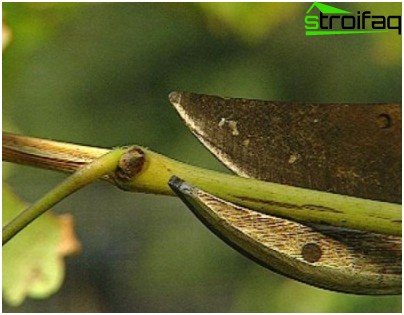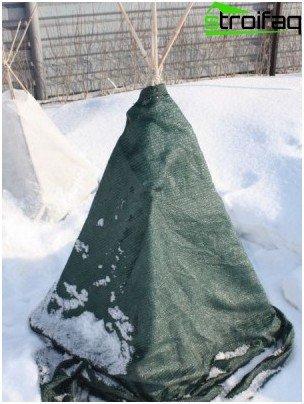Autumn care for garden roses
Rosa is the queen of the garden. She is capricious, choosy and demanding care, like all crowned persons. Work in the rose garden does not stop even with the approach of autumn, on the contrary, the most difficult arrangements for preparing roses for wintering in September are just beginning. Proper care of roses in the fall is a prerequisite for their successful exit from hibernation.
Content
- Preparing roses for hibernation
- Recipes for mineral nutrition of roses for the autumn period
- Preparing roses for wintering: stopping the growing season
- Pruning rose bushes
- Hilling – a necessary procedure
- Wrapping rose bushes – the last stage of preparation for wintering
Preparing roses for hibernation
Top dressing is the most important part of year-round care for roses of all kinds. By autumn, the composition of the top dressing should be seriously changed. Nitrogen fertilizers, including manure, are relevant during the period of active growth of a seedling, as they provoke the appearance of new shoots. From mid-August, their use ceases. Young shoots are not able to survive the winter, and with freezing and spring thawing, they can infect rot and the entire bush. Autumn dressing should contain potassium and phosphorus, provoking the rapid formation of a dense bark, which reduces the plant’s response to temperature changes.
Recipes for mineral nutrition of roses for the autumn period
- To prepare the solution requires: 10 g of potassium sulfate; 25 g of superphosphate; 2.5 g of boric acid. The composition is diluted in 10 liters of water and is used for irrigation..
- A spray solution can be prepared from equal parts of potassium monophosphate and superphosphate (15 g each) and 30 l of water. For watering, the same ingredients are diluted in 10 liters of water..
Gardeners who refuse to use ready-made factory fertilizers on a personal plot make water-enriched solutions of these substances from natural products. A good source of phosphorus and potassium is wood ash, which is simply added to the water. Another secret of experienced gardeners is banana skins dug around a shrub. A potassium-rich product will enrich the soil..
Preparing roses for wintering: stopping the growing season
Garden roses, the product of years of experimentation with crossbreeding and breeding of new varieties, have lost their natural timer, suggesting a hibernation season. Without help to frost, the rose will suit in all its glory, with buds and freshly released leaves, which will ultimately lead to the death of the bush after freezing the liquid in the plant. Caring for roses in September boils down to a suspension of vegetation.

A rose that has met frost in bloom will almost certainly die, so vegetation needs to be stopped in advance
The main measures to prevent the formation of new shoots:
- reduced watering;
- restriction of access to nutrients and oxygen to the roots;
- pinching of the resulting sprouts and buds.
Watering roses in the autumn requires a strict balance. Abundant moisture will cause the growth of fresh shoots, but a lack of fluid will affect the condition of the roots negatively. By mid-September, it is necessary to reduce the usual portion of watering by 2-3 liters, and with a large amount of natural rainfall, it is better to cover the roses with a film to prevent over-moistening of the surface root system.
Experienced gardeners do not recommend cutting stems in the fall, since fresh shoots immediately begin to appear on the cut area from the buds, but it is impossible to leave the bushes blooming and greening, since they will pull nutrients from the main structure of the plant, which will weaken it before a difficult period. The buds and shoots are plucked, that is, wriggled without removal, which leads to their natural maturation and drying out.
Loosening of the soil and digging of the soil between the bushes in this period is no longer carried out. The only work that needs to be done in the rose garden is cleaning the fallen leaves. Its decay can cause infection of the bush, so the foliage is carefully collected and burned.
Such care for roses in September should be carried out before a stable change in temperature is negative. The plant should already be prepared for colds in order to proceed to the last stages of preparation for frosts – for pruning and shelter.
Pruning rose bushes
Pruning of bushes is carried out already at a well-established temperature below zero. Early wrapping roses will not bring benefits, since an overly guarded plant will not receive sufficient immunity to the cold. All not fallen leaves and fruits, weak young shoots and excess shoots are subject to removal. To carry out these works, as well as the entire autumn care of roses, it is possible gradually, freeing the bush from excess load step by step during September and November. By November, only strong branches with dense bark should remain from the bush, able to withstand the temperature difference. The optimal number of 3-5 shoots.

Pruning of pink branches is done diagonally with sharpened secateurs
The length of the stem left depends on the height of the kidneys. 3-4 will be quite enough for the bush to grow splendidly with the onset of spring. Experienced gardeners before this procedure, usually occurring in late October or early November, are advised to consult the lunar calendar. Cutting roses is recommended for the waning moon. Several rules will allow cutting to be performed as qualitatively as possible:
- only a perfectly sharp secateurs are used that do not crush the stem when stumping;
- before use, the tool is disinfected with alcohol or a solution of manganese;
- the cut is made at an angle of 45 degrees;
- trimmed bushes are sprayed with 5% solution of copper sulfate or 3% Bordeaux fluid;
- to prevent damage to the bushes by bacteria and pests, the cuts are treated with garden varieties, and the trunks are whitened.
All garbage formed after these operations must be burned, as the dead leaves and branches are a likely source of infection for rose bushes.
Hilling – a necessary procedure
The bushes should be slightly dried up for the hilling procedure, so you can cover them from heavy rains with a film in advance by placing it around the stem. Land poured by 20-30 centimeters should be completely dry. You can add some sand or sawdust to the composition. Hilling will prevent the stems from cracking, and the upper part of the root system from freezing and dying.
Wrapping rose bushes – the last stage of preparation for wintering
Each gardener has a material for wrapping roses:
- lapnik;
- film;
- sackcloth;
- Lutrasil factory nonwoven fabric;
- paper or cardboard;
- wooden boxes.

Pyramid of rods and burlap – a simple and effective method of wrapping roses for the winter
With a difference of approaches in wrapping up, gardeners agree on one thing: caring for garden roses in the autumn must necessarily include this procedure, since in the climate of the middle zone even unpretentious park roses do not survive frosts well.
The best material for wrapping up will be one that provides a dry and relatively cool wintering. Cardboard and paper, soaking and hardening at the first thaw, are not the best option, as are oxygen-impervious film materials. Most gardeners call the optimum material the spruce branch, which provides a good temperature and the necessary ventilation. A burlap stretched over the wire frame creates approximately the same effect. Gardeners who approach the question thoroughly cover the structure from above with a wooden box.
Caring for roses in the fall is a painstaking and time-consuming process, but the diligent gardener will thank the roses in spring with plentiful flowering.







